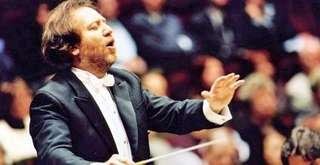|
Back
Once Brilliant, Twice Chailly New York
Avery Fisher Hall, Lincoln Center
11/10/2014 - & November 7, 2014 (Boston)
Great Performers Series:
Felix Mendelssohn: The Hebrides (“Fingals’ Cave”) – Symphony No. 5 in Dmajor (“Reformation”)
Ludwig van Beethoven: Violin Concerto D Major
Nikolaj Znaider (Violin)
Gewandhaus Orchestra of Leipzig, Riccardo Chailly (Conductor)

R. Chailly (© Courtesy of the Artist)
New York has been experiencing a mini-Mendelssohn Festival this past week. First the composer’s Walpurgisnacht, played by the Orchestra of St. Luke’s. And last night, the Hebrides overture and the Fifth Symphony played by Mendelssohn’s own orchestra, the Leipzig Gewandhaus, for their second concert, conducted by Riccardo Chailly.
No musics could be more different. Walpurgisnacht was a heavy-handed, yet charming practical joke, with an orchestra blaring, dissonant, triumphant and sometimes even reverent. Last night, two other sides of the composer were revealed: the peripatetic traveler and the devout Lutheran.
Listening to the Leipzig Gewandhaus was a revelation in itself. The oldest civic orchestra in the world, founded in 1743, its natural beauty of instrumental display has been sculpted by Kurt Masur, Arthur Nikisch and–for the last twelve years of his life– Felix Mendelssohn himself, Still, Felix Mendelssohn has not exactly been the most popular composer in America for the past decade, so to bring up his work took a bit of audacity on the part of the Gewandhaus present conductor Riccardo Chailly.
Yet this orchestra seems to have been created for the Mendelssohn orchestral tapestry. If the NY Phil and other American orchestras dash out their primary colors like Titian or Rubens, the Gewandhaus is closer to a Japanese silk screen. All is transparent, all seems to float along by itself.
Yes, the “Reformation” Symphony has its brawny passages, but with the Gewandhaus, the brasses sound more like Gabrielli in a Venetian church than a Wagnerian opera. And while the Hebrides does roll along with its stormy sections, the Gewandhaus Orchestra emphasizes winds and strings, bringing a colorful litheness.
In fact, the opening bars of the overture gave call for the inner voices. That heavenly major theme–the one which the composer sent back to his sister in Germany–is fine, but one heard all the strings, like undercurrents of the tides.
But it was in the Fifth Symphony (actually Mendelssohn’s second symphony) that was most memorable. First, because a different version was used here, where a flute solo (ravishingly played by Stephanie Winker) led the segue into the finale. And secondly, because Maestro Chailly produced the most unusual waves of sound during the Lutheran Hymn, “A Mighty Fortress” in the finale.
This, in fact, is where those wondrous sounds from the Gewandhaus were show to their utmost. As well as Mendelssohn’s inspiration and Mr. Chailly’s prowess. No fugue here, but the different forces of the orchestra entering at different times, forming a design, then a pattern, and finally the full picture of the holy movement.
True, the opening movement unfolded with the same blossoming sounds, with the radiant Dresden Amen. The second movement was Mendelssohn’s famed “fairy dance” lightness, and the third movement, with those wonderful violins, was beautifully lyrical.

N. Znaider (© Courtesy of the Artist)
The young Danish/Polish/Israeli violinist-conductor Nicolaj Znaider gave a sparkling account of the Beethoven Concerto. His technique was faultless, the upper registers on his “Kreisler” Guarnerius were dazzlingly beautiful (though I’d rather not compare them to Anne-Sophie Mutter tonight), and the last movement moved along with the gusto of a Beethoven–and the light energy of a Mendelssohn scherzo!
Harry Rolnick
|